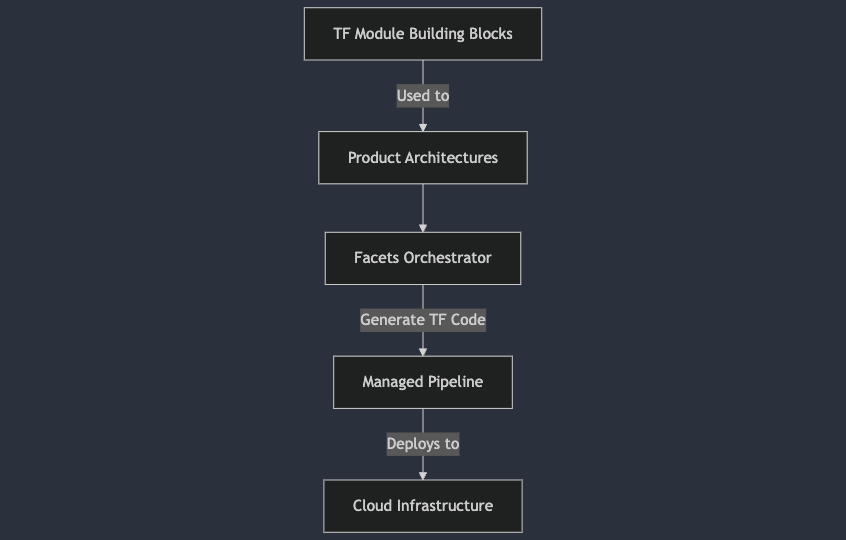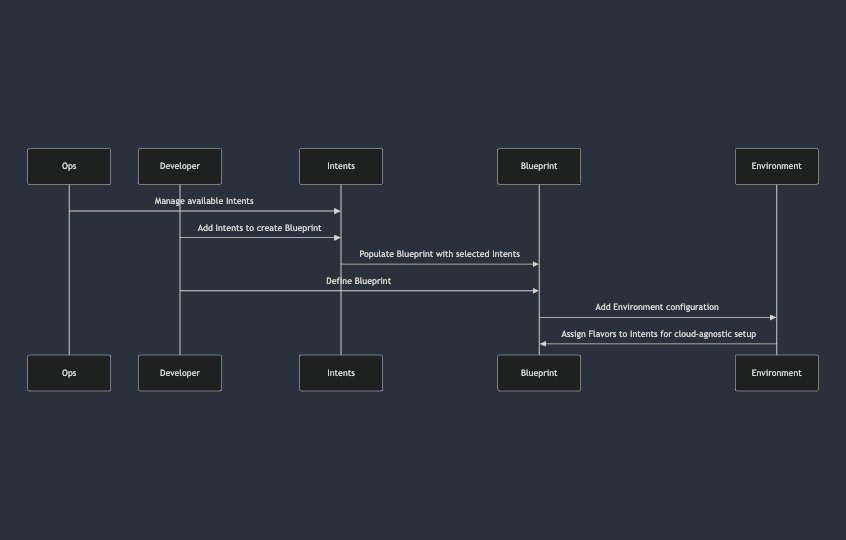How It Works?
Core Components
- Intents: High-level specifications of infrastructure requirements (e.g., database, cache).
- Flavors: Specific implementations that fulfill the Intents, represented by Terraform modules.
- Packs: Ops curated collections of Intents and Flavors to standardize infrastructure options.
- Blueprints: Product architectures created by developers using Intents and Flavors, deployable across environments.
1. Facets Architecture Flow
The Facets architecture flow outlines the process from defining infrastructure requirements to deploying a product in the cloud, without including Packs.
Steps in the Architecture Flow
- Building Blocks: Terraform modules (Flavors) curated by Ops, serving as reusable modules for infrastructure definitions.
- Intents and Flavors: Developers specify high-level requirements using Intents, linked to Flavors that provide the actual infrastructure implementations.
- Blueprints: Developers construct Blueprints by selecting Intents and corresponding Flavors to define the architecture of their product.
- Orchestrator: Transforms the Blueprint into deployable Terraform code.
- Managed Pipeline: Executes the generated code, deploying the product to the cloud infrastructure.
Diagram of the Architecture Flow

2. Intents and Flavors
Intents and Flavors are abstractions in Facets that decouple infrastructure requirements from their implementations.
Intents
- Definition: High-level declarations of what a product needs, such as a database or a load balancer.
- Purpose: Allow developers to specify infrastructure requirements without detailing specific cloud resources or configurations.
- Example: An Intent might be "Database," indicating the need for data storage capabilities.
Flavors
- Definition: Specific implementations that fulfill the Intents, represented by Terraform modules.
- Purpose: Provide the actual infrastructure setup that satisfies the requirements specified by Intents.
- Customization: Flavors can be configured within the Facets UI to meet various requirements.
- Example: Flavors for a "Database" Intent could include AWS RDS, GCP Cloud SQL, or Azure Database services.
How They Work Together
- Requirement Specification: Developers select an Intent to express a need (e.g., "I need a Database").
- Implementation Mapping: The Intent is linked to a Flavor that provides the specific implementation in the chosen cloud environment.
- Code Generation: The Orchestrator uses the Intent-Flavor combination to generate Terraform code for deployment.
3. Module Packs in Facets
Packs are collections of Intents and Flavors managed by Ops teams. They act as a registry of infrastructure capabilities, allowing developers to access reusable definitions for consistent infrastructure deployment.
Types of Packs
- Facets Module Packs: These are provided by Facets, including pre-configured Intents and Flavors designed to cover standard infrastructure needs.
- User-Created Packs: Created by organizations to include custom Intents or additional Flavors for existing Intents, tailored to specific infrastructure needs.
Function of Packs
- Ops Setup: Ops teams create Module Packs by organizing relevant Intents and corresponding Flavors.
- Standardization and Flexibility: Custom Packs allow organizations to define new infrastructure requirements or specify additional Flavors for existing requirements.
- Developer Use: Developers select Intents from Packs to create their product architecture, a Blueprint.
Packs act as a centralized registry, simplifying access to reusable infrastructure definitions and promoting consistency across products and environments.
4. Blueprints
Blueprints represent the architecture of a product as defined by developers, enabling consistent and repeatable infrastructure deployments.
Creating Blueprints
-
Selecting Intents and Flavors:
- Developers choose Intents from Packs to specify the infrastructure requirements of their product.
- For each Intent, a corresponding Flavor is selected based on the target cloud environment or implementation needs.
-
Orchestration and Deployment:
- The Orchestrator translates the Blueprint into Terraform code.
- The Managed Pipeline executes the code, deploying the infrastructure to the cloud.
Diagram of the Blueprint Flow

Summary
Facets provides a structured approach to infrastructure management by introducing abstractions that separate high-level requirements from specific implementations. Through the use of Intents, Flavors, Packs, and Blueprints:
-
Ops Teams:
- Define and manage reusable infrastructure options via Intents and Flavors within Packs.
- Ensure deployments comply with organizational standards and policies.
-
Developers:
- Create product architectures using Blueprints by selecting Intents from Packs and assigning Flavors.
- Focus on the functionality and requirements of their applications without handling low-level infrastructure code.
By adopting Facets, organizations can achieve scalable, maintainable, and compliant infrastructure deployments, aligning technical operations with business objectives.
Updated 5 months ago